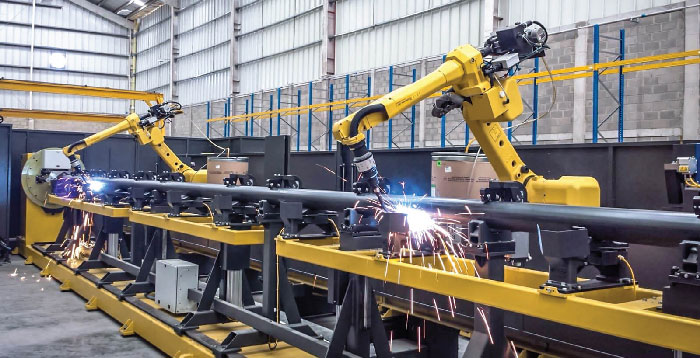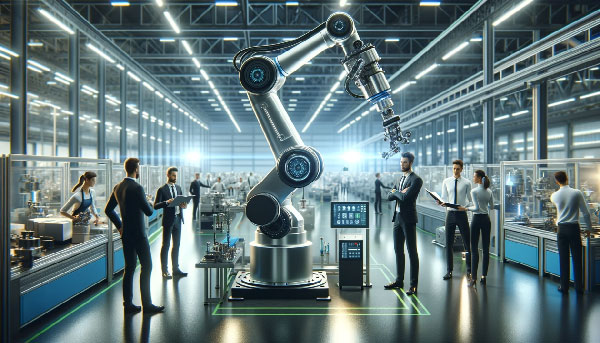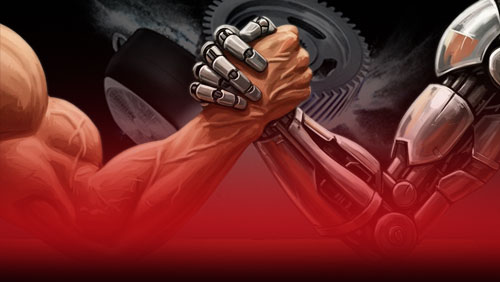How Robotic Automation is Revolutionizing Metal Fabrication in 2025
Given the global competition among manufacturerـs on the variety and quality of their products, as well as the production of new and modern products in the coming years, all companies have been encouraged to use modern devices to increase the quality, accuracy, and speed of their work.
The metal fabrication industry, integral to sectors ranging from automotive to aerospace, is experiencing a transformative shift due to the rise of robotic automation. In 2025, robotic systems are reshaping production lines, making them faster, more precise, and cost-efficient. These technological advancements are not only improving the quality of products but also allowing manufacturers to meet the increasing demand for customized and high-quality metal products.
The Role of Robotics in Metal Fabrication
Robotic automation in metal fabrication involves the use of robots to carry out various tasks such as cutting, welding, bending, and assembling metal components. Unlike traditional manual methods, robots are capable of performing these tasks with greater consistency, speed, and precision. The introduction of robotic arms, collaborative robots (cobots), and advanced sensors has made these systems more adaptable and efficient, improving production timelines while reducing human error.

One of the key applications of robotics in metal fabrication is automated welding. Robots equipped with advanced welding technologies, such as laser welding and arc welding, ensure highly accurate welds, which are essential for producing durable and strong metal components. This innovation significantly reduces the risk of defects, leading to improved product quality and less waste.
Increased Precision and Speed
The precision offered by robots in tasks like cutting and bending is unparalleled. Robots are programmed to perform operations with tight tolerances, ensuring that every part meets exact specifications. This level of accuracy minimizes the need for rework or corrections, reducing production time and costs. Furthermore, robots can operate around the clock, increasing productivity and speeding up the manufacturing process. Tasks that previously took days or hours are now completed in a fraction of the time, allowing manufacturers to meet tight deadlines and optimize their workflow.
Cost Efficiency and Labor Savings
One of the most significant benefits of robotic automation is its ability to reduce operational costs. While the initial investment in robotics can be high, the long-term savings are substantial. Robots reduce the need for a large workforce, leading to lower labor costs and fewer workplace injuries. Additionally, robotic systems require less maintenance and downtime compared to human workers, further improving cost-effectiveness. The ability of robots to perform repetitive and dangerous tasks also minimizes human exposure to hazardous environments, contributing to safer working conditions.

Customization and Flexibility
The demand for customized metal products is growing, driven by industries like automotive and construction, which require specific parts and components for unique applications. Robotic automation allows for greater flexibility in production, enabling manufacturers to easily adjust their processes for different designs and specifications. Robots can be reprogrammed and retooled to accommodate varying production needs, making it easier to switch between different tasks without significant downtime.
Moreover, robots equipped with advanced machine learning algorithms can optimize their own operations. For example, a robot can learn the most efficient path for cutting metal pieces based on previous production data, thereby improving productivity and reducing waste.
Challenges and Considerations
Despite the many advantages, there are challenges associated with integrating robotic automation into metal fabrication processes. The initial investment required for high-quality robotic systems can be significant, and smaller manufacturers may struggle to afford these technologies. Additionally, there is a learning curve involved in adopting robotic systems, as workers need to be trained to work alongside robots and manage these systems effectively.

Another point is the possibility of job displacement. While robots can perform repetitive tasks, the need for skilled specialists in programming, maintaining and monitoring robotic systems is increasing. This change requires either adding new human resources or providing training courses at the expense of the employer to improve skills and adapt to the demands of modern devices.
In the future
Looking ahead, the future of robotic automation in metal fabrication is incredibly promising. In 2025, it is expected that robots will become even more intelligent, capable of performing more complex tasks with minimal human intervention. Advances in artificial intelligence (AI) and machine learning will allow robots to autonomously detect and correct errors during the manufacturing process, further enhancing quality control. Additionally, the integration of 3D printing technologies with robotics could pave the way for new production methods, allowing for the creation of highly intricate and customized metal parts.

As robots become more integrated into the workforce, the industry will likely see an even greater emphasis on collaboration between humans and machines. Collaborative robots, or “cobots,” are designed to work alongside humans, sharing tasks and complementing human skills. This collaborative approach will help bridge the gap between automation and human labor, creating a more efficient and harmonious manufacturing environment.
Conclusion
Robotic automation is fundamentally changing the landscape of metal fabrication, offering significant advantages in terms of speed, precision, cost efficiency, and flexibility. As we approach 2025, the industry is poised to continue benefiting from these technological advancements. By embracing robotics, manufacturers can stay competitive in an increasingly globalized market, meet rising demand for customized products, and improve overall efficiency. While challenges remain, the future of metal fabrication is undeniably shaped by the ever-growing role of robotics in shaping the industry’s future.




